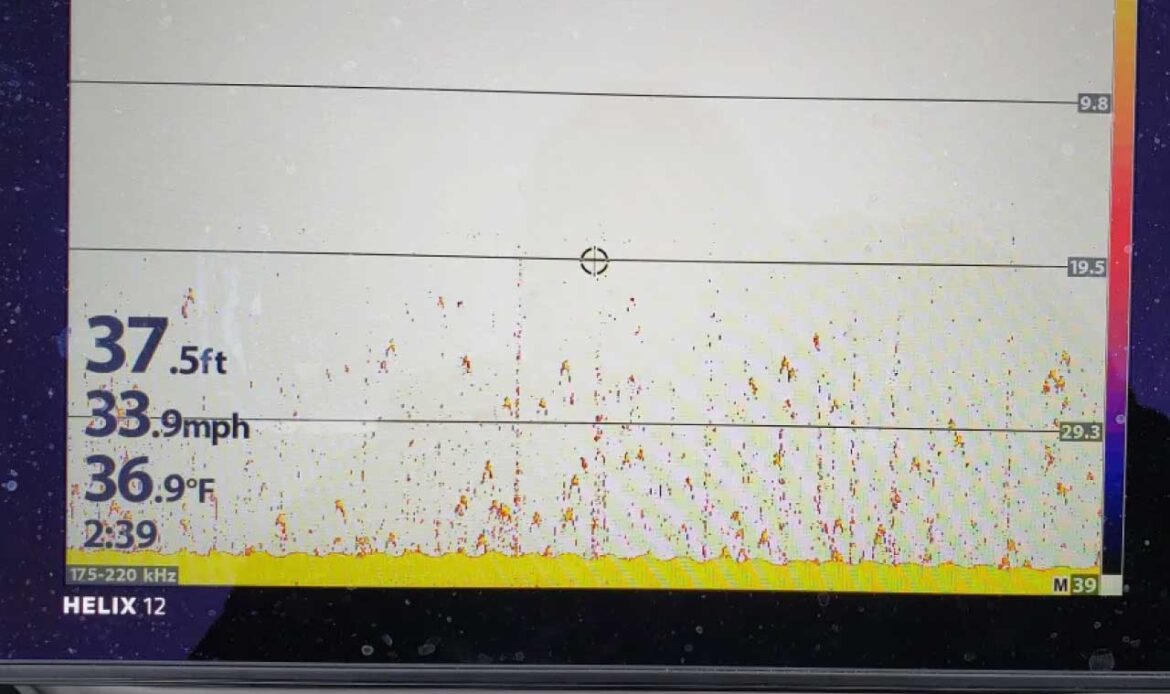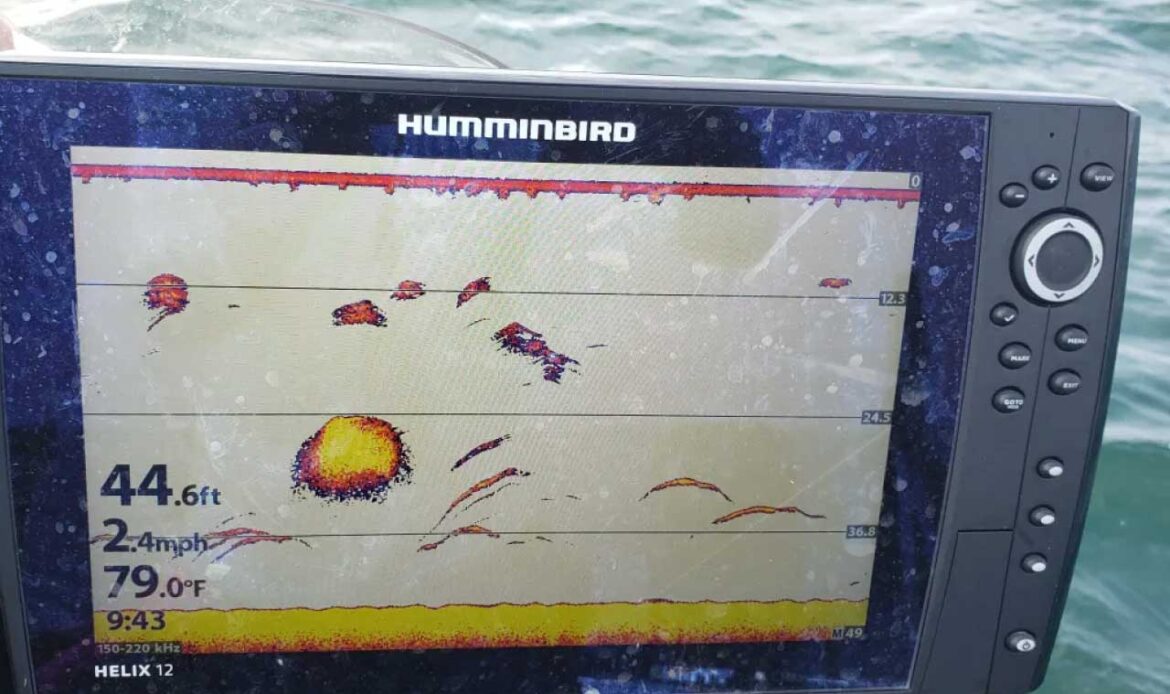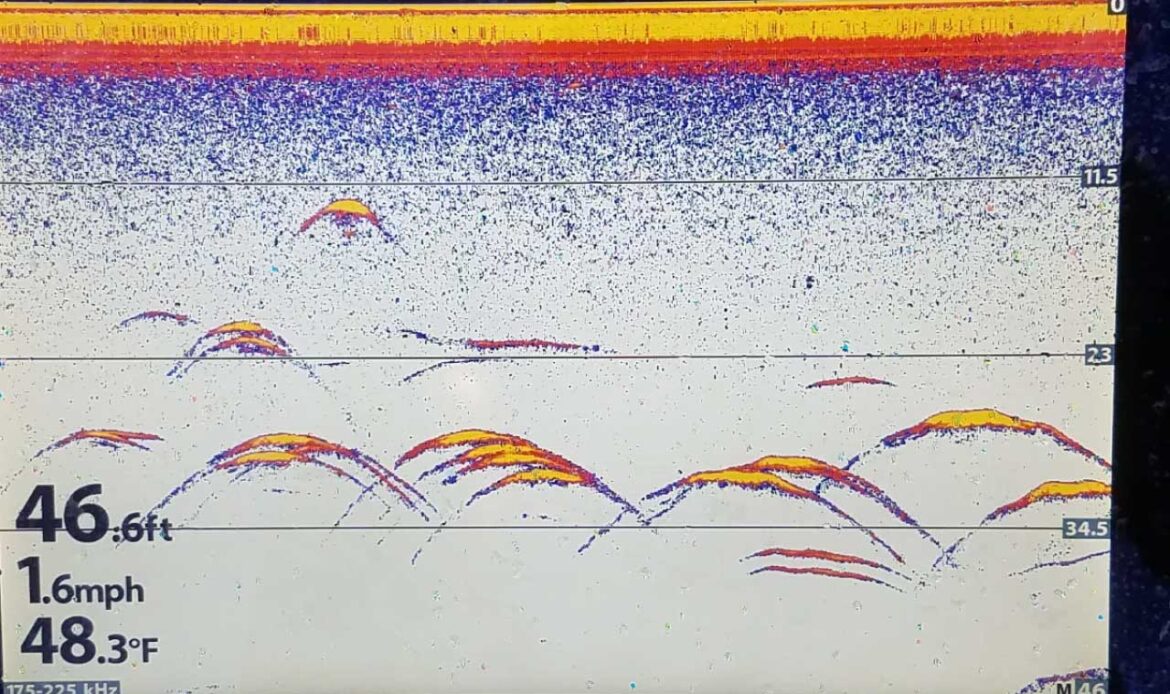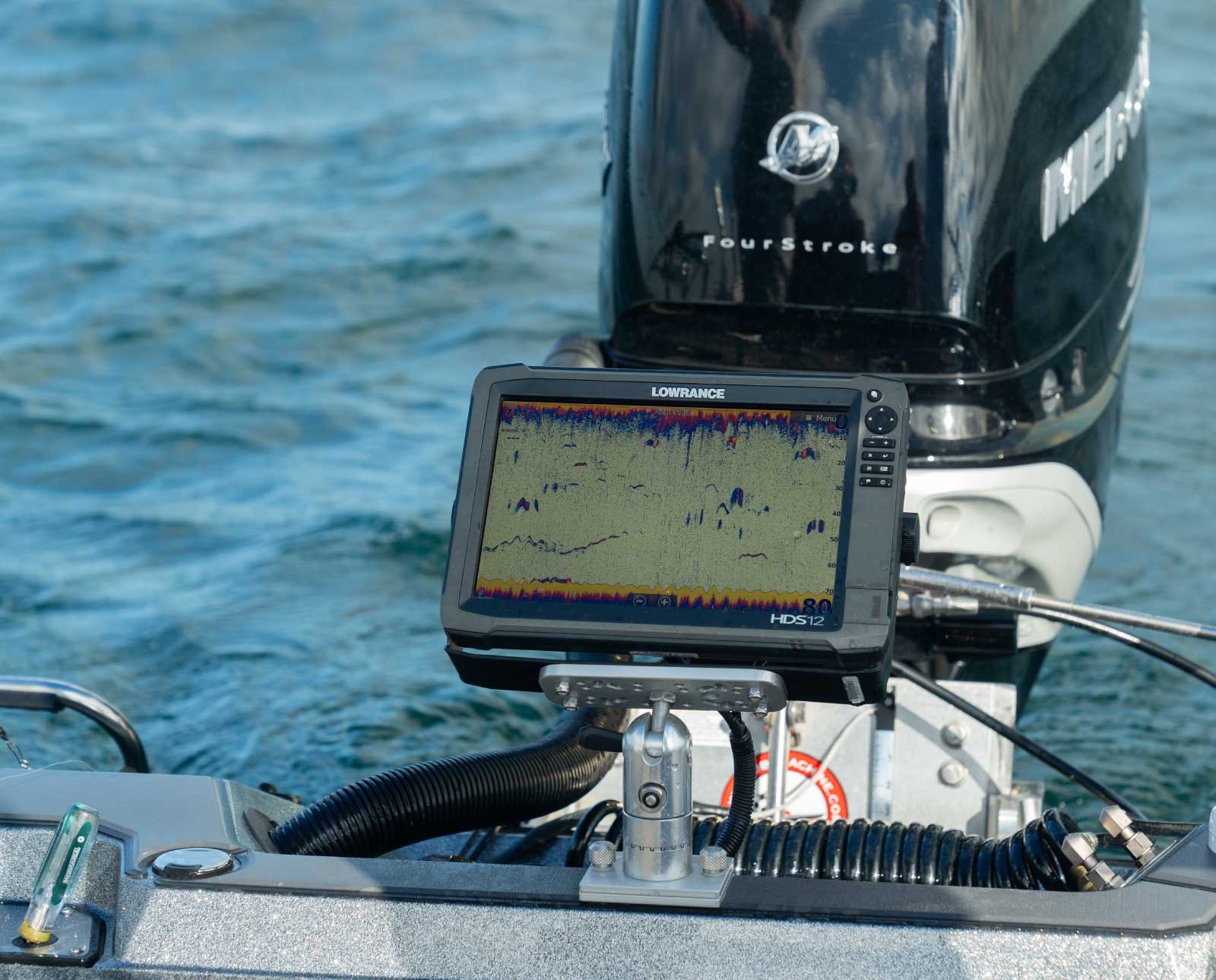These tips and tactics will help you locate elusive walleye on lake Erie this fishing season.
I think it’s fair to say that walleyes are like ghosts. One minute they are seemingly everywhere and easily found, the next they just seem to vanish into thin air. One important element about walleyes that you always need to remember however is that they don’t go far from the grocery store. Here are a few simple tips that will help you better locate and stay on fish throughout the year.
Finding Walleye During Cool Water Periods on Lake Erie
In the spring or fall when water temps are less than 55 degrees one of the biggest tools you can use to find walleyes is actually your own eyes. Winds are synonymous with cooler water periods and these winds quickly change water clarity.

High Speed Marks in Cool Water: In this pic, a large number of walleyes are marked at 33mph in water less than forty degrees. When the water is this cold walleyes are typically found in large quantities in very small areas. This is why locating them at high speeds is so critical. It should be noted that walleyes will look like small BB’s or very small tight V shape marks due to the boat going over them at such a high rate of speed.
Water Clarity is Important for Walleye on Lake Erie
Look for water that is off-colored, but not extremely dirty or clear. While you will often see tons of marks in the extremely dirty water these marks are often not walleye or fish that just won’t bite. In dirty water, the strike zone can be so small due to limited visibility that getting a bite can be futile. Think of it like trying to find a cupcake in the middle of the night in a hay field.
The same can also be said believe it or not in extremely clean water in the cooler periods. The colder water doesn’t support as much life since the water is often several degrees cooler and baitfish don’t occupy this water for long periods of time. Instead, baitfish prefer slightly off-colored water that many professionals refer to as “chalky”. Chalky water isn’t clean and isn’t dirty, with visibility around a couple of feet. Walleyes also seem to prefer this chalky water not only because of the large amounts of baitfish but also because it lets them hide. Finding this chalky water is the easiest way to find fish that are often in very small areas within large bodies of water such as Lake Erie.
Many anglers wonder what chalky actually is and how we can all stay on the same page. Ironically, it’s our outboard motor that can help with that. Anglers that have outboard motors actually use the motor itself as a gauge. If you can see your cavitation plate the water is “fishable”, but being able to see your prop is almost perfect. When you can read the writing on your prop easily the water is often judged to be too clean. While this method of judging water clarity can seem a bit archaic, it is surprisingly accurate and helps anglers have a similar point of reference on different parts of the lake. Water clarity can be deceiving as the sun and cloud levels change and it is easy to misinterpret actual clarity.
Satellite imagery is one of your best friends for checking up-to-date images of the water without driving all over the lake with no plan of action. This helps to give you an updated version of the lake regardless of where you intend on fishing. If there is a knock on this free and readily available information it is that cloud cover can often make getting an update for several days impossible.
Finding Walley on Lake Erie During Warm Water Periods
In the summer months, walleyes are much easier to find on sonar units because they are much deeper in the water column and less spooked by the boat. Walleyes that are 30 to 40 or more feet deep mark easily on sonar units and give you a great place to start looking. I think it is fair to say that they are bottom-oriented at this time of year as well.
It’s at this time of year that you don’t want to fish a blank screen and spending some time driving around to mark a school is a very effective use of your time. Look for contours that drop off into deeper water quickly and where the bottom transitions from harder to softer. This could be a rock to compacted mud transition, or even from sand to mud.

Bait Balls and Summer Walleye: When baitfish are present walleyes typically aren’t far behind. While most of the walleye were deep in the water column, bait balls and isolated schools of baitfish up in the water column brought these walleye marks up off the bottom from 30 to 37ft deep.
On Lake Erie, good examples of these migrations are the fish moving from the western basin to the deeper water of the central basin. Fish can be found from the sandbar near Lorain all the way to the Ohio border. Throughout the summer fish tend to keep moving farther east as the water continues to warm and baitfish move easterly. Ports such as Fairport Harbor, Geneva, Ashtabula, and Conneaut are prime areas once summer is in full swing.
Another key in the summer months is to locate the best part of the water column which often means looking for a temperature break. When the water starts to layer you can get a temperature break and even a thermocline in the deeper water of Lake Erie’s central and eastern basins.
In order to see this break on your sonar unit turn up the sensitivity slightly until you see a steady and distinct, but thin line across the unit. This typically occurs from 30 to 50 feet down. Look to fish just slightly above it is often the most productive area in the water column and where baitfish and walleyes will linger.
How to Identify Walleye With Electronics
One of the most misunderstood parts of walleye fishing is properly identifying what is actually happening on your sonar screen. Knowing what to look for will help you eliminate water faster and allow you to spend more time fishing over larger amounts of fish.

Walleye Marks: It is essential to understand that the slower your boat is traveling the longer and more spread out of a V walleyes will mark as. When traveling on plane and marking fish at a faster rate of speed they will only be seen as an extremely tight V or resemble a BB as they are not in the transducer cone as long.
The reality is, there is no guaranteed trick to stay on the often moving and weary walleyes; but using your eyes, sonar unit and a little bit of common sense will help ensure you stay on the fish year around.



